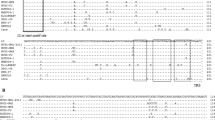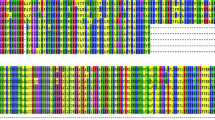Abstract
Porcine reproductive and respiratory syndrome virus (PRRSV) isolates belonging to the European genotype 1 have recently emerged in South Korea, suggesting potential problems for disease control. In the present study, we attempted to determine the complete nucleotide sequence of the first Korean type 1 PRRSV isolate, designated KNU-07. The full-length genome of KNU-07 was found to be 15,038 nucleotides in length, which was 60 nucleotides shorter than the type 1 prototype strain Lelystad due to a notable 60-bp deletion within the nonstructural protein 2 (NSP2). The KNU-07 genome was shown to consist of a 221-nucleotide (nt) 5′ untranslated region (UTR), a 14,703-nt protein-coding region, and a 114-nt 3′ UTR, followed by a 42-73-bp poly(A) tail. A nucleotide sequence comparison of the KNU-07 genome with 20 complete PRRSV genomes revealed a 10.5–13.3% and 39.5–40.3% divergence from type 1 and type 2 strains, respectively, at the genome level, indicating a high similarity to the virus strains commonly identified as the European genotype. In order to investigate genetic variation and to understand the molecular evolution of the type 1 isolate in Korea, extensive phylogenetic analyses were performed using the ORF5 and ORF7 nucleotide sequences of published type 1 PRRSV isolates. The data further indicated that the newly emerging type 1 isolate KNU-07 belongs to the recently proposed pan-European subtype 1. Taken together, the results of this study describe the genomic characterization of the type 1 PRRSV isolated in South Korea, suggesting a recent introduction of the virus typical for this genotype that has commonly appeared worldwide.




Similar content being viewed by others
References
Albina E (1997) Epidemiology of porcine reproductive and respiratory syndrome (PRRS): an overview. Vet Microbiol 55:309–316
Bautista EM, Faaberg KS, Mickelson D, McGruder ED (2002) Functional properties of the predicted helicase of porcine reproductive and respiratory syndrome virus. Virology 298:258–270
Benfield DA, Nelson E, Collins JE, Harris L, Goyal SM, Robison D, Christianson WT, Morrison RB, Gorcyca D, Chladek D (1992) Characterization of swine infertility and respiratory syndrome (SIRS) virus (isolate ATCC VR-2332). J Vet Diagn Invest 4:127–133
Cavanagh D (1997) Nidovirales: a new order comprising Coronaviridae and Arteriviridae. Arch Virol 142:629–633
Dewey C, Charbonneau G, Carman S, Hamel A, Nayar G, Friendship R, Eernisse K, Swenson S (2000) Lelystad-like strain of porcine reproductive and respiratory syndrome virus (PRRSV) identified in Canadian swine. Can Vet J 41:493–494
Fang Y, Rowland RRR, Roof M, Lunney JK, Christopher-Hennings J, Nelson EA (2006) A full-length cDNA infectious clone of North American type 1 porcine reproductive and respiratory syndrome virus: expression of green fluorescent protein in the Nsp2 region. J Virol 80:11447–11455
Keffaber KK (1989) Reproductive failure of unknown etiology. Am Assoc Swine Pract Newslett 1:1–9
Key KF, Haqshenas G, Guenette DK, Swenson SL, Toth TE, Meng XJ (2001) Genetic variation and phylogenetic analyses of the ORF5 gene of acute porcine reproductive and respiratory syndrome virus isolates. Vet Microbiol 83:249–263
Kim JY, Lee SY, Sur JH, Lyoo YS (2006) Serological and genetic characterization of the European strain of the PRRSV isolated in Korea. Korean J Vet Res 46:363–370
Lee C, Calvert JG, Welch SW, Yoo D (2005) A DNA-launched reverse genetics system for porcine reproductive and respiratory syndrome virus reveals that homodimerization of the nucleocapsid protein is essential for virus infectivity. Virology 331:47–62
Madsen KG, Hansen CM, Madsen ES, Strandbygaard B, Botner A, Sorensen KJ (1998) Sequence analysis of porcine reproductive and respiratory syndrome virus of the American type collected from Danish swine herds. Arch Virol 143:1683–1700
Meng XJ, Paul PS, Halbur PG, Lum MA (1995) Phylogenetic analysis of the putative M (ORF 6) and N (ORF 7) genes of porcine reproductive and respiratory syndrome virus (PRRSV): implication for the existence of two genotypes of PRRSV in the U.S.A. and Europe. Arch Virol 140:745–755
Meulenberg JJ, Hulst MM, de Meijer EJ, Moonen PJM, den Besten A, De Kluyver EP, Wensvoort G, Moormann RJM (1993) Lelystad virus, the causative agent of porcine epidemic abortion and respiratory syndrome (PEARS), is related to LDV and EAV. Virology 192:62–72
Meulenberg JJ, Petersen-den Besten A, De Kluyver EP, Moormann RJ, Schaaper WM, Wensvoort G (1995) Characterization of proteins encoded by ORFs 2 to 7 of Lelystad virus. Virology 206:155–163
Nelsen CJ, Murtaugh MP, Faaberg KS (1999) Porcine reproductive and respiratory syndrome virus comparison: divergent evolution on two continents. J Virol 73:270–280
Nelson EA, Christopher-Hennings J, Drew T, Wensvoort G, Collins JE, Benfield DA (1993) Differentiation of US and European isolates of porcine reproductive and respiratory syndrome virus by monoclonal antibodies. J Clin Microbiol 31:3184–3189
Nuemann EJ, Kliebenstein JB, Johnson CD, Mabry JW, Bush EJ, Seitzinger AH, Green AL, Zimmerman JJ (2005) Assessment of the economic impact of porcine reproductive and respiratory syndrome on swine production in the United States. J Am Vet Med Assoc 227:385–392
Oleksiewicz MB, Botner A, Nielson J, Storgaard T (1999) Determination of the 5′-leader sequences from radically disparate strains of porcine reproductive and respiratory syndrome virus reveals the presence of highly conserved sequence motifs. Arch Virol 144:981–987
Oleksiewicz MB, Botner A, Toft P, Grubbe T, Nielson J, Kamstrup S, Storgaard T (2000) Emergence of porcine reproductive and respiratory syndrome virus deletion mutants. Correlation with the porcine antibody response to a hypervariable site in the ORF3 structural glycoprotein. Virology 267:135–140
Page RDM (1996) Treeview: an application to display phylogenetic trees on personal computers. Comput Appl Biosci 12:357–358
Pirzadeh B, Gagnon CA, Dea S (1998) Genetic and antigenic variation of porcine reproductive and respiratory syndrome virus major envelope GP5 glycoprotein. Can J Vet Res 62:170–177
Ropp SL, Mahlum Wees CE, Fang Y, Nelson EA, Rossow KD, Bien M, Arndt B, Preszler S, Steen P, Christopher-Hennings J, Collins JE, Benfield DA, Faaberg KS (2004) Characterization of emerging European-like porcine reproductive and respiratory syndrome virus isolates in the United States. J Virol 78:3684–3703
Sagripanti JL, Zandomeni RO, Weinmann R (1986) The cap structure of simian hemorrhagic fever virion RNA. Virology 151:146–150
Saitou N, Nei M (1987) The neighbor-joining method: a new method for reconstructing phylogenetic trees. Mol Biol Evol 4:406–425
Sambrook J, Russell DW (2001) Molecular cloning: a laboratory manual, 3rd edn. Cold Spring Harbor Laboratory, Cold Spring Harbor
Snijder EJ, Meulenberg JJ (1998) The molecular biology of arteriviruses. J Gen Virol 79:961–979
Stadejek T, Oleksiewicz MB, Scherbakov AV, Timina AM, Krabbe JS, Chabros K, Potapchuk D (2008) Definition of subtypes in the European genotype of porcine reproductive and respiratory syndrome virus: nucleocapsid characteristics and geographical distribution in Europe. Arch Virol 153:1479–1488
Thompson JD, Gibson TJ, Plewniak F, Jeanmougin F, Higgins DG (1997) The ClustalX windows interface: flexible strategies for multiple sequence alignment aided by quality tools. Nucleic Acids Res 25:4876–4882
van Dinten LC, Rensen S, Gorbalenya AE, Snijder EJ (1999) Proteolytic processing of the open reading frame 1b-encoded part of arterivirus replicase is mediated by nsp4 serine protease and is essential for virus replication. J Virol 73:2027–2037
van Marle G, Dobbe JC, Gultyaev AP, Luytjes W, Spaan WJ, Snijder EJ (1999) Arterivirus discontinuous mRNA transcription is guided by base pairing between sense and antisense transcription-regulating sequences. Proc Natl Acad Sci USA 96:12056–12061
Wensvoort G, Tepstra C, Pol JMA, ter Laak EA, Bloemraad M, de Kluyver EP, Kragten C, van Buiten L, den Besten A, Wagenaar F, Broekhuijsen JM, Moonen PLJM, Zestra T, de Boer EA, Tibben HJ, de Jong MF, van Veld P, Groenland GJR, van Gennep JA, Voets MT, Verheijden JHM, Braamskamp J (1991) Mystery swine disease in the Netherlands: the isolation of Lelystad virus. Vet Q 13:121–130
Wootton SK, Yoo D, Rogan D (2000) Full-length sequence of a Canadian porcine reproductive and respiratory syndrome virus (PRRSV) isolate. Arch Virol 145:2297–2323
Wu WH, Fang Y, Farwell R, Steffen-Bien M, Rowland RR, Christopher-Hennings J, Nelson EA (2001) A 10-kDa structural protein of porcine reproductive and respiratory syndrome virus encoded by ORF2b. Virology 287:183–191
Yoo D, Welch SK, Lee C, Calvert J (2004) Infectious cDNA clones of porcine reproductive and respiratory syndrome virus and their potential as vaccine vectors. Vet Immunol Immunopathol 102:143–154
Yoon SH, Song JY, Lee CH, Choi EJ, Cho IS, Kim B (2008) Genetic characterization of the Korean porcine reproductive and respiratory syndrome viruses based on the nucleocapsid protein (ORF7) sequences. Arch Virol 153:627–635
Zeman D, Neiger R, Yaeger M, Nelson E, Benfield D, Leslie-steen P, Thomson J, Miskmins D, Daly R, Minehart M (1993) Laboratory investigation of PRRS virus infection in three swine herds. J Vet Diagn Investig 5:522–528
Acknowledgments
This work was supported by grant no. Z-AD21-2008-08-02 from the National Veterinary Research and Quarantine Service (NVRQS), Ministry for Food, Agriculture, Forestry and Fisheries, Republic of Korea.
Author information
Authors and Affiliations
Corresponding author
Rights and permissions
About this article
Cite this article
Nam, E., Park, CK., Kim, SH. et al. Complete genomic characterization of a European type 1 porcine reproductive and respiratory syndrome virus isolate in Korea. Arch Virol 154, 629–638 (2009). https://doi.org/10.1007/s00705-009-0347-3
Received:
Accepted:
Published:
Issue Date:
DOI: https://doi.org/10.1007/s00705-009-0347-3




